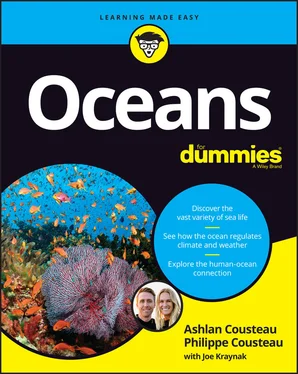1 ...7 8 9 11 12 13 ...23 Well, the difference between weather and climate is that weather is affected by short-term changes in the atmosphere, which can still cause a cold spell when there shouldn’t be one, whereas climate describes the AVERAGE weather in an area over a LONG PERIOD of time. For example, weather in a desert may be rainy or sunny on a particular day, but the climate is dry. Likewise, most of South Florida has a tropical climate (hot and humid), but the weather on some days may be cool and dry relative to Florida’s seasonal climate.
So let’s be very clear: Climate change (global warming) is real. According to an ongoing temperature analysis conducted by scientists at NASA’s Goddard Institute for Space Studies (GISS), the average global temperature on Earth has increased by more than 1 degree Celsius (1.8 degrees Fahrenheit) since 1880. That may not seem like much, but it is. Head over to Chapter 17for more about climate change (global warming) and how it’s bad news for the ocean and for us.
The ocean also plays a key role in the water cycle — the continuous process by which water is carried around the world through evaporation, condensation, precipitation (rain and snow), and transpiration (the movement of water through plants). Even though the ocean is salt water, water that evaporates from the ocean’s surface is fresh water, and much of it falls to the ground as rain or snow, bringing us essential water for drinking and for growing food.
 Nearly all precipitation that falls on land originates in the ocean.
Nearly all precipitation that falls on land originates in the ocean.
The water that evaporates combined with heat from the ocean’s surface is responsible for the powerful storms that unleash their energy over land, often damaging coastlines and destroying property, but this is all part of the ocean’s role in regulating the weather and contributing to the water cycle. By the way, the ocean’s surface temperature can also impact the severity of storms, making them weaker or stronger.
Producing Protein for Billions of People
Humans and our ancestors have been eating seafood for a looooooooooong time. Yep, in a cave called Figueira Brava, located outside Lisbon (Portugal), remains of harvested mussels date back to a Neanderthal dinner some 80,000 to 160,000 years ago. Evidence also shows that Homo sapiens harvested shellfish at South Africa’s Pinnacle Point between 164,000 and 120,000 years ago. So our love of seafood and its important nutrients goes way back.
According to the World Wildlife Fund, three billion people around the world today depend on wild-caught or farmed seafood as their primary source of protein. Now that’s a whole lot of sushi (and other seafood), and it doesn’t count consumption by the other five billion or so people on the planet. That makes seafood the largest traded food commodity on Earth. But this incredible ocean bounty is being pulled out at unsustainable rates; 90 percent of all fish stocks today are either over-fished or fished to capacity (see Chapters 19and 21for details).
To feed the nine or close to ten billion people estimated to populate the planet by 2050, we need to make sure our fisheries are healthy and brimming with fish. According to one estimate ( oceana.org/feedtheworld ), with the right management and restoration, we could increase global fish stocks by 15 percent, enough fish to feed one billion people a seafood meal every single day.
 Save the fish! One way you can contribute to a sustainable ocean is by switching supplements. Currently, fish and krill are a main source of omega 3s in most supplements. But fish and krill get their omega 3s from algae, so all you need to do is cut out the middleman by switching from fish oil to algae oil. Algae pills provide the same omega 3 benefits, but they’re vegetarian, tasteless (no nasty fish burps after taking them), and ocean-friendly. Why make the switch? Well, the fish oil/krill oil industry is wreaking havoc on the marine food web. See Chapter 21to find out more about what can be done to restore marine life populations and diversity.
Save the fish! One way you can contribute to a sustainable ocean is by switching supplements. Currently, fish and krill are a main source of omega 3s in most supplements. But fish and krill get their omega 3s from algae, so all you need to do is cut out the middleman by switching from fish oil to algae oil. Algae pills provide the same omega 3 benefits, but they’re vegetarian, tasteless (no nasty fish burps after taking them), and ocean-friendly. Why make the switch? Well, the fish oil/krill oil industry is wreaking havoc on the marine food web. See Chapter 21to find out more about what can be done to restore marine life populations and diversity.
Contributing Trillions to the Global Economy
Sticking a price tag on the ocean is a real challenge. How would you go about measuring its economic value? Would you use a metric like the one used for countries — gross domestic product (GDP)? And if the value of the ocean could be quantified, would it be considered rich compared to the countries with the biggest economies?
Well, in 2015, the World Wildlife Fund, the Global Change Institute (at the University of Queensland), and the Boston Consulting Group set out to quantify the ocean’s economic value. They did so by adding up the dollar value of the various benefits gained through fisheries, tourism, shipping, and coastal protection from coral reefs and mangroves, to name a few.
This massive analysis concluded that the sea is worth … wait for it … US$24 trillion. That’s trillion, with a “T.” Its annual gross marine product (the equivalent of GDP) was estimated to be US$2.5 trillion a year. That would rank the ocean as the world’s seventh largest economy, sitting between the United Kingdom and Brazil. Maybe, just maybe the ocean should have a seat at the G7 Summit … we’re just sayin’.
Here’s the breakdown from the study:
| Ocean Asset |
US$ Trillion |
| Marine fisheries |
2.9 |
| Mangroves |
1.0 |
| Coral reefs |
0.9 |
| Seagrass |
2.1 |
| Shipping lanes |
5.2 |
| Productive coastline |
7.8 |
| Carbon absorption |
4.3 |
| TOTAL |
24 |
Back to the study. The people crunching the numbers admitted to being unable to factor in less tangible benefits of the ocean — you know, little things like producing over half of Earth’s oxygen, anchoring the water cycle, and regulating weather and climate. They didn’t even consider oil and minerals (from offshore drilling and mining), wind power, or the ocean as a source of new medicines. As a result, their estimates represent a vast undervaluation of the ocean’s worth to humanity, let alone all the other living creatures on the planet, but it is a good place to start and underscores just how important the ocean is to our global economy.
Visit www.worldwildlife.org/publications/reviving-the-oceans-economy-the-case-for-action-2015 for additional details from the study.
Serving as a Source of Mystery and Wonder
Since the beginning of time, people have been seduced by the sea, its sound, its power, its vastness, and its creatures, all of which have captivated, enchanted, and inspired humankind. The ocean has served for many generations as muse to some of the world’s greatest authors, inspiring classics such as The Old Man & The Sea, Moby Dick, Twenty Thousand Leagues Under the Sea, Treasure Island, Homer’s Odyssey, The Tempest, and more. Artists have drawn, painted, and sculpted its seascape and creatures, both real and mythical. Musicians have sung of the sea’s soul for millennia. And the ocean plays a prominent role in many religions across the globe.
While it continues to inspire authors and artists, more recently in human history, the ocean has also inspired scientists, and it continues to do so. Exploring the ocean from surface to seafloor and from coastlines to the middle of the deep blue sea not only goes a long way toward satisfying human curiosity, but also uncovers new sources of food, medicines, and energy; provides insight on how to conserve ocean resources; and enhances safety through a better understanding of earthquakes, tsunamis, hurricanes, and other natural threats to human life and property. In addition, the physical challenges of deep-sea exploration often lead to valuable innovations.
Читать дальше

 Nearly all precipitation that falls on land originates in the ocean.
Nearly all precipitation that falls on land originates in the ocean.










